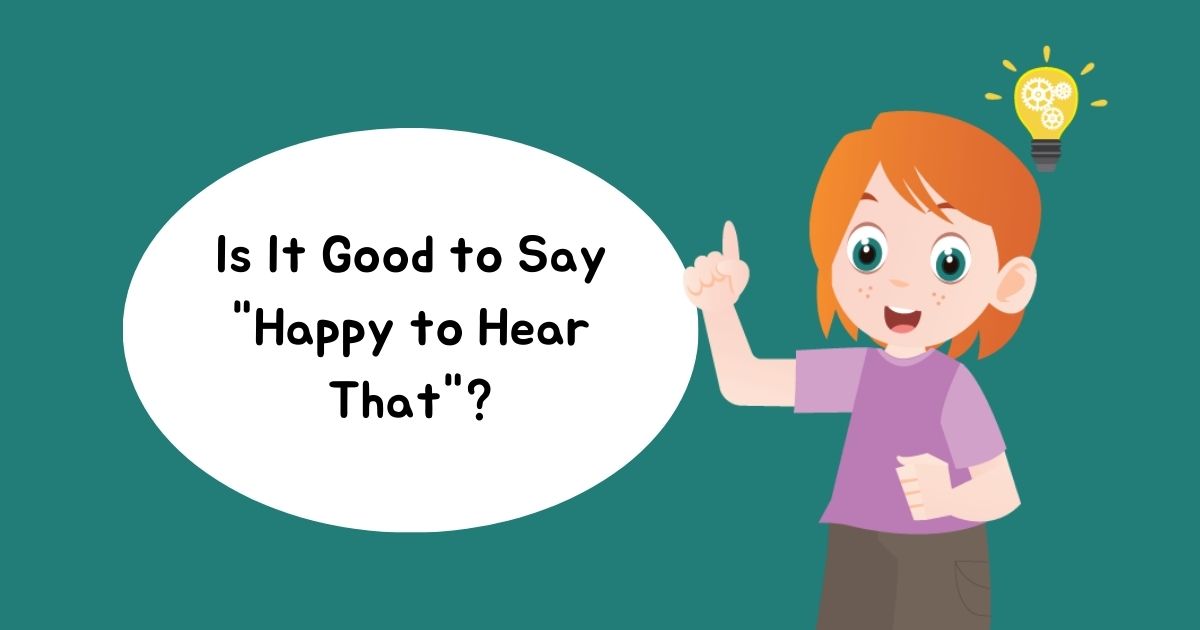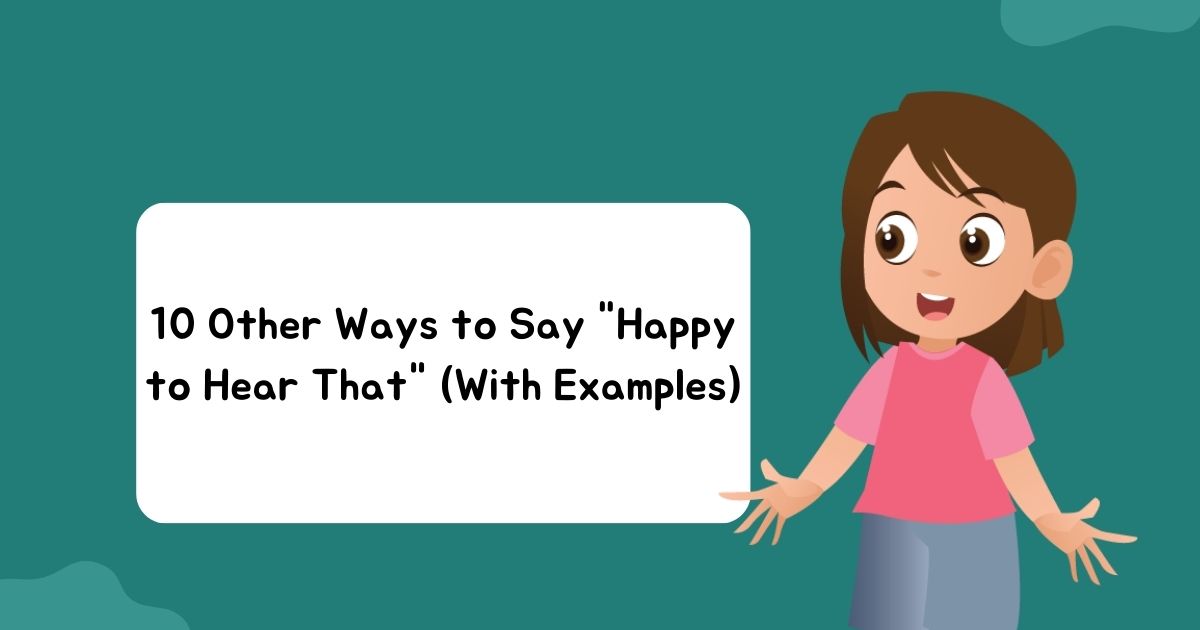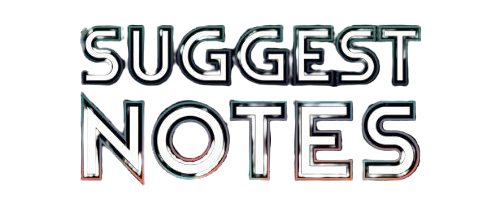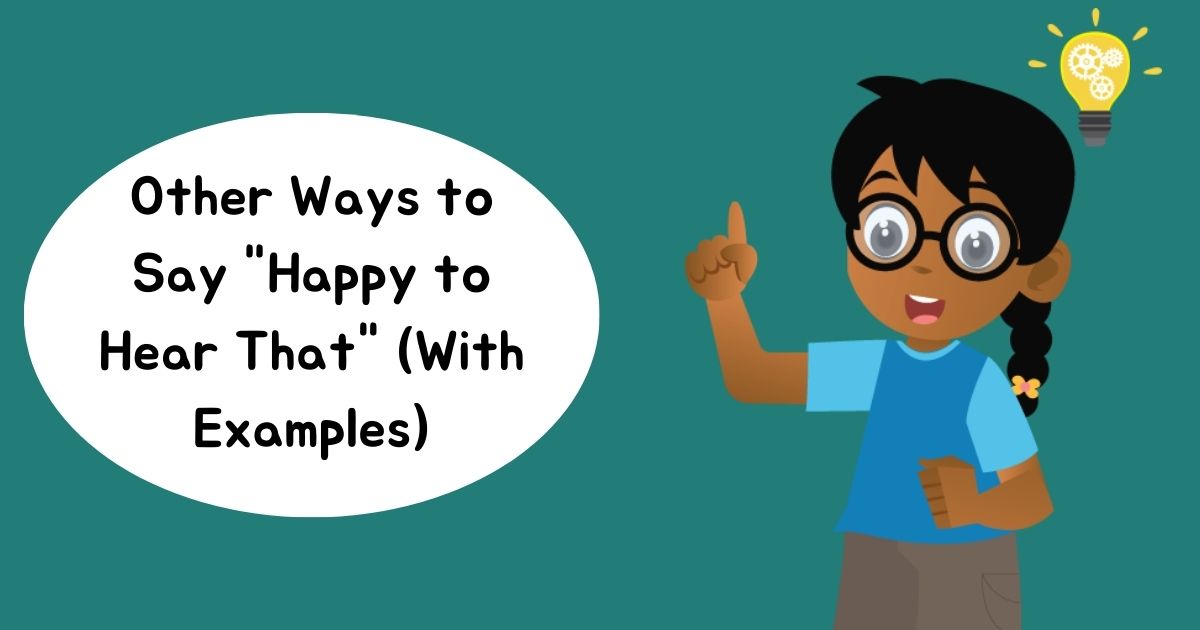It’s time to expand your vocabulary and express joy in more creative ways. In this article, we’ll explore 10 fresh alternatives to “happy to hear that” along with real-world examples. By the end, you’ll have a toolkit of varied responses to use in both personal and professional settings.
Having different ways to say “happy to hear that” can help you sound more enthusiastic and keep conversations positive and engaging. From showing elation to demonstrating recognition, these alternatives will help you convey enthusiasm more effectively.
Is It Good to Say “Happy to Hear That”?

Saying “happy to hear that” is generally a very positive response when someone shares good news with you. It conveys that you are genuinely pleased to learn about their situation and enthusiastic about what they told you.
Using this phrase lets the person know that you appreciate them sharing their news with you and that you are glad to know about their positive update or development. However, like any phrase, it can become repetitive if overused. That’s why having alternative expressions in your conversational toolkit is helpful.
What to Say Instead of “Happy to Hear That”

Here are 10 different phrases you can use to voice happiness when someone shares good news:
- That’s great to hear!
- I’m so glad to hear that.
- That makes me very happy.
- What wonderful news!
- I’m thrilled to hear that.
- That put a smile on my face.
- You’ve made my day with that news.
- I’m so pleased to hear that.
- That’s such a relief to hear.
- I’m delighted that’s the case.
1. That’s great to hear!
“That’s great to hear.” is an enthusiastic response that conveys a sense of joy and approval upon receiving good news. This expression is versatile and can be used in both formal and informal contexts, making it a popular choice for everyday conversations.
- For example, if a friend shares their recent job promotion, you might respond with, “Congratulations, that’s great to hear! Your hard work truly paid off.”
- In a professional setting, upon hearing about successful project completion, one might say, “I’m impressed with your team’s performance, that’s great to hear.”
2. I’m so glad to hear that.
Expressing that you’re “so glad to hear that” conveys a deep sense of personal joy and satisfaction with the news received. It’s a heartfelt response that shows empathy and a strong personal bond to the person sharing the news.
- For instance, if a relative tells you they’re expecting a baby, you might say, “That’s wonderful, I’m so glad to hear that! The family is growing.”
- When a colleague overcomes a challenging situation, you might comment, “I knew you could do it, I’m so glad to hear that it worked out.”
3. That makes me very happy.
Saying “That makes me very happy” is a direct way to express that the news brings individual joy. It implies a strong emotional connection to the outcome and shows that the news positively affects your mood or state of mind.
- For example, when a friend graduates from college, you might say, “Seeing you achieve your goals makes me very happy. Congratulations.”
- If a family member recovers from an illness, you could express, “Hearing about your recovery makes me very happy; health is the most important.”
4. What wonderful news!
The exclamation “What wonderful news!” is an expressive way to acknowledge that the information shared is exceptionally positive and welcome. It emphasizes the speaker’s perception of the news as being particularly delightful or fortunate.
- For instance, if a neighbour tells you they won a community award, you might respond, “Really? What wonderful news! Your dedication to the community is admirable.”
- When a colleague announces they’re moving to a dream location, you might say, “That’s a big step, what wonderful news! I wish you all the best in your new home.”
5. I’m thrilled to hear that.
“I’m thrilled to hear that” conveys a level of excitement and elation about the news that goes beyond mere happiness. It suggests that the news is not only positive but also somewhat exhilarating or deeply satisfying to the speaker.
- For example, if a sibling shares news of getting into their top-choice university, you might say, “You worked so hard for this, I’m thrilled to hear that you got in!”
- In a business setting, upon learning your company has landed a major contract, you might express, “This is a game-changer for us, I’m thrilled to hear that we secured the deal.”
6. That put a smile on my face.
The phrase “That put a smile on my face” is a vivid way to express that the news brought immediate joy and pleasure, visually represented by the act of smiling. It suggests that the news had a direct and positive impact on the speaker’s mood.
- For example, if a friend shares a small but meaningful achievement, you might respond with, “Hearing about your success put a smile on my face. Keep up the great work!”
- When receiving a thank-you note from a client, you could reply, “Your kind words put a smile on my face. It was a pleasure working with you.”
7. You’ve made my day with that news.
Saying “You’ve made my day with that news” elevates the impact of the news to a level where it significantly brightens the speaker’s entire day. This expression conveys a profound sense of appreciation and happiness, indicating that the news stands out as a highlight in the speaker’s day.
- For instance, if a loved one shares an unexpected positive development, you might say, “You’ve made my day with that news! I’m so happy for you.”
- When a colleague shares news of team achievement, you might express, “This is fantastic, you’ve made my day with that news! Congratulations to everyone involved.”
8. I’m so pleased to hear that.
“I’m so pleased to hear that” is a polite and formal way to express satisfaction and happiness about the news received. This phrase is often used in professional settings or when a certain level of decorum is required, effectively conveying approval without overstepping boundaries of formality.
- For example, when a mentee informs you about their recent professional advancement, you might say, “Your progress is impressive, I’m so pleased to hear that you’ve been promoted.”
- In a formal setting, upon hearing positive feedback about a project, one might respond, “Thank you for your feedback, I’m so pleased to hear that our efforts have been well received.”
Related Guide:
10 Other Ways to Say “Have a Great Weekend” (With Examples)
9. That’s such a relief to hear.
The expression “That’s such a relief to hear” is used when the news alleviates worries, concerns, or uncertainties, providing comfort and reassurance. It’s particularly appropriate in situations where there was prior tension or anxiety regarding the outcome, and the positive news brings a welcome sense of release.
- For instance, if a friend awaits important medical results, you might say, “I’ve been so worried, that’s such a relief to hear everything is fine.
- ” When a project faces significant challenges but ultimately succeeds, you might express, “Given the hurdles we faced, that’s such a relief to hear we’ve delivered successfully.”
10. I’m delighted that’s the case.
“I’m delighted that’s the case” is a formal and sophisticated way to express intense pleasure and happiness about the situation or outcome being discussed. This phrase conveys a strong personal satisfaction and is often used in both personal and professional contexts where a high level of respect and formality is maintained.
For example, if a colleague completes a difficult task, you might say, “Your dedication is commendable, I’m delighted that’s the case.” In a personal context, upon learning a family member has achieved a long-sought goal, you could express, “Your perseverance is inspiring, I’m delighted that’s the case. Congratulations!”
FAQ’s
What does “Happy to Hear That” mean?
“Happy to Hear That” expresses genuine pleasure or relief in response to someone’s good news or positive situation. It conveys support and encouragement.
When is it appropriate to use “Happy to Hear That”?
You can use it in conversations where someone shares positive updates or achievements, such as promotions, good health, or happy personal events. It helps foster a supportive atmosphere.
Can “Happy to Hear That” be used in professional settings?
Absolutely! It’s a great way to acknowledge a colleague’s success or positive feedback during meetings or emails, enhancing workplace morale and relationships.
How can I respond if someone says “Happy to Hear That” to me?
A simple “Thank you” or “I appreciate your support!” works well. It acknowledges their response and keeps the positive conversation flowing.
Is “Happy to Hear That” suitable for formal communication?
While it’s generally more casual, it can be adapted for formal settings. Consider the context and your relationship with the recipient to ensure it feels appropriate.
Conclusion
In conclusion, hearing uplifting news can truly brighten our days and lift our spirits. It reminds us of the positivity that exists around us and encourages us to share our own good news with others. Embracing happiness, whether in our lives or in those of others, creates a ripple effect that spreads joy far and wide.
As we navigate through life’s ups and downs, let’s celebrate the moments that make us smile. Being happy to hear good news not only strengthens our connections but also nurtures a sense of community. So, let’s continue to share and cherish those joyful moments together.

As a content writer with five years of experience, I focus on creating insightful and impactful website content that drives engagement and boosts search visibility. With a strong foundation in SEO and digital marketing, I excel at crafting compelling narratives that resonate with audiences and enhance brand storytelling. My passion for data-driven content creation allows me to deliver pieces that not only inform but also inspire action. Whether through blog posts, web copy, or informative articles, I strive to empower businesses to connect authentically with their customers.







